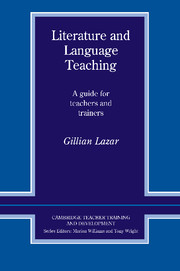Book contents
- Frontmatter
- Contents
- Thanks
- Acknowledgements
- Introduction
- 1 Using literature in the language classroom: The issues
- 2 Approaches to using literature with the language learner
- 3 Selecting and evaluating materials
- 4 Reading literature cross-culturally
- 5 Materials design and lesson planning: Novels and short stories
- 6 Materials design and lesson planning: Poetry
- 7 Materials design and lesson planning: Plays
- 8 Reflecting on the literature lesson
- 9 Literature and self-access
- Answer key
- Trainer's notes
- Bibliography
- Appendix: Eveline by James Joyce
- Index
2 - Approaches to using literature with the language learner
Published online by Cambridge University Press: 04 May 2010
- Frontmatter
- Contents
- Thanks
- Acknowledgements
- Introduction
- 1 Using literature in the language classroom: The issues
- 2 Approaches to using literature with the language learner
- 3 Selecting and evaluating materials
- 4 Reading literature cross-culturally
- 5 Materials design and lesson planning: Novels and short stories
- 6 Materials design and lesson planning: Poetry
- 7 Materials design and lesson planning: Plays
- 8 Reflecting on the literature lesson
- 9 Literature and self-access
- Answer key
- Trainer's notes
- Bibliography
- Appendix: Eveline by James Joyce
- Index
Summary
The aim of this chapter is to examine the possible approaches which you could draw on when using literature with your students. Pinpointing possible approaches can help us to select and design materials for classroom use, as well as to assess the suitability of published materials. We begin by considering these approaches in very general terms; later sections will examine some of the issues and problems they raise in more specific detail.
An overview
Below are three quotes taken from books which use literature in the language classroom. Although there is some overlap between the books in terms of overall aims and methodological assumptions, they do have slightly different ways of selecting, organising and exploiting their material. By examining these quotes more carefully, we may begin to gather together some clues about approaches we could adopt when using literature with our students. Read through the quotes and then think about the questions which follow.
A. If carefully selected, poems can open up themes which are common to us whatever our cultural background, and can thus act as a powerful stimulus to the students’ own reflective thinking, which will lead to more mature and fruitful group discussion.
(Maley and Moulding (1985), Poem into Poem, p. 135.)B. Reading Literature provides students with an introduction to the reading of British and American literature. It concentrates on helping them actually read what are sometimes difficult texts, while at the same time giving them help with literary history, biography, differences in genre, technical literary terminology and literary criticism.
(Gower and Pearson (1986), Reading Literature, p. 1.)- Type
- Chapter
- Information
- Literature and Language TeachingA Guide for Teachers and Trainers, pp. 22 - 47Publisher: Cambridge University PressPrint publication year: 1993

